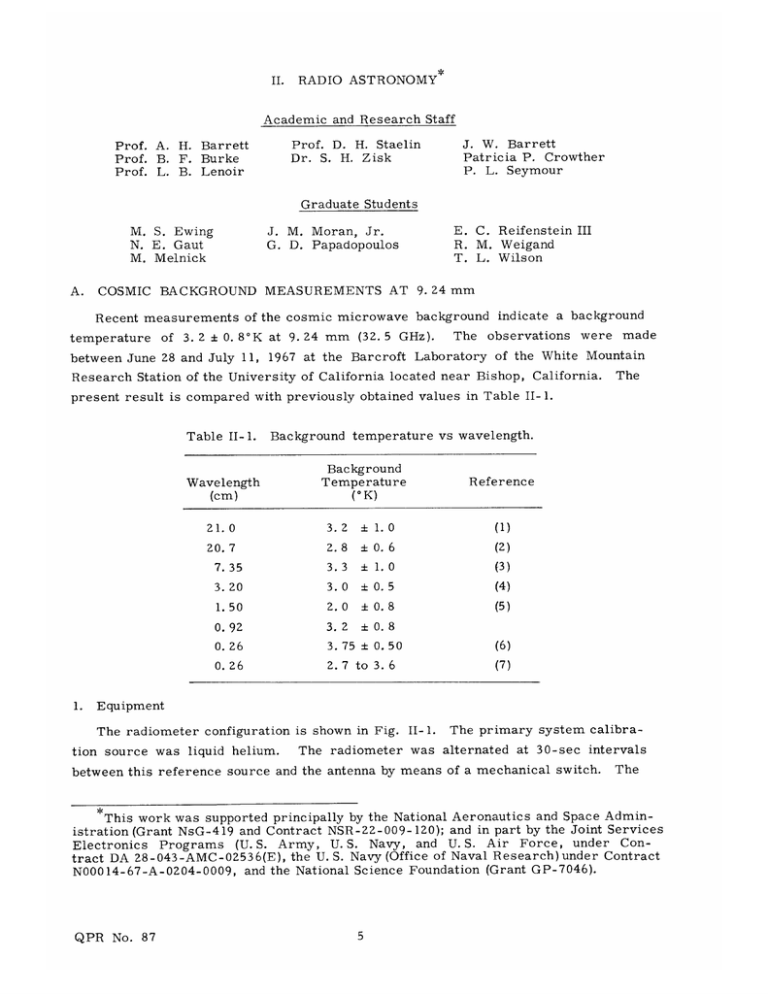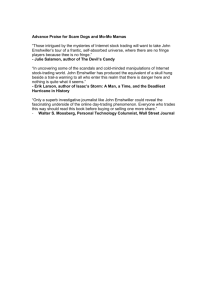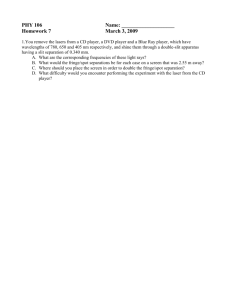II. RADIO ASTRONOMY Academic and Research Staff
advertisement

II. RADIO ASTRONOMY Academic and Research Staff Prof. D. H. Staelin Dr. S. H. Zisk Prof. A. H. Barrett Prof. B. F. Burke Prof. L. B. Lenoir J. W. Barrett Patricia P. Crowther P. L. Seymour Graduate Students J. M. Moran, Jr. G. D. Papadopoulos M. S. Ewing N. E. Gaut M. Melnick A. E. C. Reifenstein III R. M. Weigand T. L. Wilson COSMIC BACKGROUND MEASUREMENTS AT 9. 24 mm Recent measurements of the cosmic microwave background indicate a background 0 The observations were made temperature of 3. 2 ± 0. 8 K at 9. 24 mm (32. 5 GHz). between June 28 and July 11, 1967 at the Barcroft Laboratory of the White Mountain Research Station of the University of California located near Bishop, California. The present result is compared with previously obtained values in Table II- 1. Table II-1. Background temperature vs wavelength. Wavelength (cm) 1. Background Temperature ( 0 K) Reference 21.0 3.2 ± 1.0 (1) 20. 7 2.8 ± 0. 6 (2) 7. 35 3. 3 ± 1. 0 (3) 3. 20 3.0 ± 0. 5 (4) 1.50 2.0 ± 0. 8 (5) 0. 92 3.2 ± 0. 8 0. Z26 3.75 ± 0.50 (6) 0. 26 2. 7 to 3. 6 (7) Equipment The radiometer configuration is shown in Fig. II-1. tion source was liquid helium. The primary system calibra- The radiometer was alternated at 30-sec intervals between this reference source and the antenna by means of a mechanical switch. The *This work was supported principally by the National Aeronautics and Space Administration (Grant NsG-419 and Contract NSR-22-009-120); and in part by the Joint Services Electronics Programs (U. S. Army, U. S. Navy, and U. S. Air Force, under Contract DA 28-043-AMC-02536(E), the U. S. Navy (Office of Naval Research) under Contract N00014-67-A-0204-0009, and the National Science Foundation (Grant GP-7046). QPR No. 87 0 00 CALIBRATION PRIMARY SKY HORN COLD LOAD" NOISE TUBE COLD LOAD WINDOW SECONDARY COLD REFERENCE FERRITE SWITCH MECHANICAL MECHANICAL WAVEGUIDE SWITCH (period - 60 sec. ) ISOLATOR o PRIMARY COLD . .REFERENCE LIQUID He LEVEL ABSORBER Fig. II- 1. Radiometer. MIXER F CSC I ATnR ( 170 Hz) (II. RADIO ASTRONOMY) receiver gain was calibrated every 5 minutes by a 50 0 K signal from an argon discharge tube. The discharge tube was calibrated daily against a 300*K absorber placed over the sky antenna. The radiometer output had an rms fluctuation of 0. 1VK for a 1-hour integration time. The secondary reference antenna and the "cold load" antennas were small horns aimed at arbitrary regions of sky to provide conveniently "cold" and stable sources of radiation. The helium reference load was an array of fiber glass spikes clad with nichrome film. The spikes filled the lower 8 cm of a 6. 3-cm diameter cylinder 40 cm long (Fig. II-1). In operation, the spikes were submerged in liquid helium boiling at the ambient atmospheric pressure, thus assuring their temperature. The can, made of gold-flashed copper and copper-plated stainless steel, formed an oversize waveguide at the operating wavelength and assured low loss. Temperature of the upper wall was measured by means of a thermocouple. The first mode was absoThe radiometer was used in two distinct modes. lute measurement of the zenith brightness temperature. Differences between the signal and reference paths were minimized by using identical 20-db standard gain horns ° (20 beamwidth) on either side of the mechanical switch in a mechanically One horn looked down into the helium load while the other Temperatures at various points looked up at the zenith as indicated in Fig. II-1. The entire switch-horn assembly on the horns were measured by thermocouples. A pyramidal was inverted every few days to check for electrical asymmetry. symmetric manner. shield was placed directly around the upper horn to reduce the effect of side- lobes. The second mode was the determination of the brightness of the earth's atmo- This was accomplished by tipping the radiometer to various zenith angles (z), measuring differences in antenna temperature, and fitting the results to a function approximately of the form T 1 + T 2 sec (z). A 26-db horn (100 beamwidth) sphere. and 300 bend replaced horn to sweep from the upper 20-db horn in a manner that allowed the larger z = 00 to z = 600, while the dewar was tilted at most 300 from vertical. moist air was kept from the system by a window A slight flow of warm helium of Saran wrap over the mouth of the upper horn. gas was introduced into the waveguide system to prevent water vapor or cold The helium dewar was vented directly helium from entering the switch or horns. In either operating mode, to air. A large system of shields was erected around the radiometer to further shield the radiometer from the ground and sky below z = 77". absolute zenith measurements is shown in Fig. 11-2. QPR No. 87 The radiometer as set up for Fig. II-2. Radiometer being prepared for absolute zenith measurement. (II. 2. RADIO ASTRONOMY) Results A typical experiment consisted of a helium dewar fill, discharge tube calibration, an absolute zenith measurement for 1 hour, a half-hour atmospheric measurement, refill, and 1 1/2 hours of atmospheric measurement. dewar After such an experiment the apparatus would be completely warmed and dried for several hours. Observations were allowed only when the sun was more than 30 removed from the antenna beam and during times of few or no clouds. 16- 15- 144.5 0 K SLOPE 13- 12- 1.5 sec (z) Fig. 11-3. Tipping data (July 10, 1967). 2.0 Flags represent expected rms error. The atmospheric observations are subject to different sources of error and hence may be discussed apart from the absolute measurements. Brightness temperature (TOBS) was measured at several values of z, but at least twice as much time was at z = 00 and z = 600 as at other angles. surement is presented in Fig. 11-3. mately determined by the relation TOBS(z) = T QPR No. 87 1 + TATM sec (z) A typical plot of a 2-hour atmospheric mea- If the atmospheric brightness (TATM) is approxi- (II. RADIO ASTRONOMY) for some constant T 1, then TATM = TOBS( 6 0 ) - TOBS(O0 ) + AT, where AT = 0. 24'K for TATM 4K is a correction due to the combined effects of antenna sidelobes, finite optical thickness of the atmosphere, and an error in pointing TATM measured at the Barcroft Laboratory ranged from 3. 4 0K to 5. 5 0 K the antenna. with a mean of 4. 04 0 K. Errors in the absolute zenith measurement include asymmetry in the mechanical switch and horn assembly, loss in the window, and cooling of the lower horn by cold helium gas. These errors were measured radiometrically. There was found a switch 0 asymmetry (Tsw) ranging from 0. 4°K to 0. 9 K on different days, while the window was found to contribute T W = 0.91 ± . 05'K. The lower horn was typically 35°C cooler than the upper; this was found to produce a differential brightness THL = 0. 21 ± .06 Ohmic loss in the helium load wall was calculated to produce TWL = . 07 0 K(rms). .05 0 K. Sidelobes of the sky antenna are calculated to increase TOB by TSL = .03 TATM' S Reflectivity of the helium reference load and leakage into the load were measured to produce a negligible increase in load temperature. The cosmic background temperature (TBG) may be expressed as + TBG = a -1[TOBS +THE -TATM + TWL -THL -T SL], Tsw-T where a is the attenuation coefficient of the atmosphere, (3) which for TAT M = 4°K is approximately 0. 984. The measurements upon which our determination of TBG is based are given in Table II-2. These represent about 13. 2 hours of observation. errors in estimation of TB G A summation of the leads to a maximum total error of ±0. 78 0 K giving the final value, TBG = 3. 2 ± 0. 8 0 K. Table II-2. Date Summary of data. TOB S TATM SW TBG 7/ 1/67 4. 52K 5. 540 K -0.44 0 K 2.88 0 K 7/ 3/67 3. 58 3. 89 -0.44 3. 77 7/10/67 2. 46 4. 52 0. 51 2. 88 7/11/67 2. 43 4. 30 0. 70 3. 12 mean The data of Table II-2 account for approximately vation time. QPR No. 87 3. 16 ± 0. 18 K (rms) one-third of the total obser- The rest of the data were rejected on several grounds: sudden change (II. RADIO ASTRONOMY) in weather, internal inconsistency, etc. If all of the observations are averaged together, however, the resulting cosmic background temperature is 3. 7 K. M. S. Ewing, D. H. Staelin, B. F. Burke, D. C. Papa References 1. 2. 3. A. A. Penzias and R. W. Wilson, paper presented at the American Astronomical Society Meeting, Los Angeles, 1966 (unpublished). T. F. Howell and J. R. Shakeshaft, Nature 210, 1318 (1966). A. A. Penzias and R. W. Wilson, private communication, 1966. 6. P. G. Roll and D. T. Wilkinson, Phys. Rev. Letters 16, 405 (1966). W. J. Welch et al., Phys. Rev. Letters 18, 1068 (1967). P. Thaddeus and J. F. Clauser, Phys. Rev. Letters 16, 819 (1966). 7. G. B. Field and J. Hitchcock, Astrophys. J. 146, B. VERY LONG BASELINE INTERFEROMETRY WITH INDEPENDENT TIME STANDARDS 4. 5. 1 (1966). The OH emission sources associated with many H II regions exhibit remarkable 1-3 The polarization properties, anomalous intensity ratios, and narrow linewidths. individual lines originate in regions of small angular size, as shown by interferometer measurements.4-6 A recent measurement, using the 120-ft telescope of Lincoln Laboratory, M. I. T., Haystack Microwave Research Facility and the Agassiz 60-ft telescope of Harvard College Observatory as a 74,000 X interferometer, showed that the strongest components of the emission complex associated with the radio source W3 (IC 1795) were unresolved, although the source positions for individual lines were not coincident, while 8 the Jodrell Bank-Malvern group has shown that the strongest feature, at a radial velocity of -45.1 km/sec, is unresolved with a 700, 000 wavelength baseline. Further increases in baseline length have been made possible by the advent of highly stable atomic frequency standards, and recent results have been reported by the Algonquin-Penticton group 9 and by the NRAO-Arecibo group10 who have observed fringes from continuum sources with baselines of 4. 6 X 106 and 4. 6 x 105 wavelengths, respectively. Rather than deriving local oscillators from a common reference and transmitting the received IF signals to a common point as in conventional interferometry, the local oscillators at each station are phase-locked to an atomic frequency standard. The received signal is converted to video frequencies, and then recorded, with time information, on magnetic tape in digital or analog form. The records are later reduced at a data processing center, and fringe amplitudes derived by crosscorrelation the two sets of measurements. The present results were obtained by using the Haystack 120-ft telescope and the 140-ft telescope of the National Radio Astronomy Observatory. The separation of the QPR No. 87 (II. RADIO ASTRONOMY) two instruments is 845 km, or 4. 7 x 106 wavelengths at 1665. 4 MHz, which corresponds to a fringe spacing of .044 second of arc. The Haystack station used a hydrogen frequency standard (Varian Model H- 10) as a frequency reference, and data were recorded on magnetic tape through the U490 computer that services the antenna. A rubidium frequency standard (Varian Model R20) was used at the NRAO, and data were recorded on one of the two magnetic tape systems developed by the NRAO-Arecibo group. In both recording systems, the received signals were clipped, sampled, and recorded digitally. Full spectral information is thus retained, except for a scale factor. The absolute value of the power spectrum is easily recovered, however, when the system noise temperature is known and the total power is measured, as it was in this experiment. Relative timing of the two stations is important, although not as critical as in wideband continuum measurements, because of the narrow linewidths, which are typically of the order of 2 kHz. The master Loran-C station at Cape Fear, North Carolina, was used to set our station clocks, and microsecond timing accuracy was achieved. In order to compensate for the high rate at which a source travels through the interference fringes, which could be several hundred Hz, the local oscillators were set to different precomputed frequencies, to rotate the fringes with the source. An alternative way of looking at the fringe compensation is to regard the fringe rate as arising from the beating between the two signals, since they are Doppler-shifted by different amounts by the earth's rotation. The individual local oscillator offsets thus compensate for this differential Doppler shift, as well as for the common corrections due to the earth's orbital motion and the motion of the sun with respect to the local standard of rest. Observations were conducted during the period June 8-12, 1967. Observing bandwidths of either 6 kHz or 120 kHz were used in the observations, and a variety of OH emission sources was observed. Circularly polarized feeds were used on both antennas, and either sense of polarization could be selected. The reductions completed thus far have concentrated on the strongest feature in the 1665-MHz spectrum of W3. This line has a radial velocity of -45.1 km/sec with respect to the local standard of rest, and is strongest when right circularly polarized radiation is received. The 6-kHz bandwidth is wide enough to display the complete line profile, and the presence of the line on each computer tape was easily verified by taking the Fourier transform of the autocorrelation function for each set of data. The fringe phase and amplitude of the interferometric combination was derived by the method outlined by Rogers.ll The recorded video signals were crosscorrelated at delay intervals, centered on the expected geometric time delay for the observed source. The crosscorrelation function was taken over periods of .02 sec, which was short compared with the apparent fringe period. The time dependence of the crosscorrelation function was removed through multiplication by a trial function, equivalent T, to a local-oscillator offset. QPR No. 87 This operation, when the trial function is correctly chosen, Fringe phase -180 Unnormalized fringe amplitude -90 ......... I.o.. o. o .... . . ... .............. . ........ 1tI I I I. I * S *1 * * eItI * I I I I I * * II, • oo *1t I.I * *I ! 'a ....... 180 0.o..- .... It I I: I * * * I I * * eI I* * I ItI I It I.I I• I•I I *I ! • S 1' I * Ie 1* I 1' * Unnormalized fringe amplitude . .o . •........ * .. I.. -- . . .*. . . .•. . . . .*. . -180 . . .,o . . I* I I It I* I0 I II Fringe phase 0 90 -.. . ~ . . . . I I I * * * t * I I SiI I * ! I* I* I' * * I ** II I I5 * II II -180 I I * *i * II * 9 Fringe phase 90 0 -90 180 I I I1I II * * I II II * * II * ~ III * * Si sfucin of 0 ffeuecro te-5 I I II II I I I I I I * I I S I I * i I * I I S I * !* IS * QPR No. 87 I * I I Ir I* * Fig. 11-4. I I * II I Unnormalized fringe amplitude I' * II * S * 5* I * I'5' 1 III I * S * I 0 * * I I Zr II I I I I * * II I 180 .. . * II I I I I SI . ..-. * ! I I . * I I I ** ! -90 I I * mscln *I *I *I * fW.Fe I * I *I Sample computer outputs of fringe amplitude and phase as a function of frequency for the -45. 1 km/sec line of W3. Frequency axis is horizontal, and covers a total bandwidth of 6 kHz. The records shown are for relative frequency offsets of . 0, .025, and .050 Hz. (II. RADIO ASTRONOMY) converts the crosscorrelation function to a time-independent function, R(T), from whose complex Fourier transform the fringe amplitude and phase can be derived as a function of frequency. The apparent local oscillator offset can be caused by a real difference between the two frequency standards, or by an error in the adopted baseline. The two effects can be separated by observation of the diurnal variation of the frequency offset. An incorrect frequency offset diminishes the apparent fringe visibility, so a range of offsets was covered to make certain that the fringe visibility was maximized. Examples of the computer output are shown in Fig. 11-4, which shows fringe amplitude and phase of the -45. 1 km/sec line of W3, as seen in right circular polarization, for 3 values of frequency offset. The frequency scales run horizontally, and cover a range of 6 kHz, with an effective resolution of 500 Hz. An integration time of 20 seconds was used in deriving the profiles shown. and .050 Hz, The relative frequency offsets are 0. 0, .025, and it is clear that the offset can be determined to better than .01 liz. This corresponds to an accuracy of 6 parts in 1012 in measuring the apparent frequency difference, and with sufficiently improved. 0. 1 Hz. record, long integration the Over the 4-day observing period, accuracy could be significantly the offset correction varied less than The fringe visibility was derived from taking autocorrelation spectra of each and comparing the observed fringe amplitude with the expected value. The -45. 1 km/sec line of W3 has been observed over a range of 14 hours in hour angle, and the fringe visibility is 1. 0 ± 0. 2 over the entire range. We can find no evi- dence of resolving the source, which implies an upper limit to the apparent size of .02 second of arc, for the equivalent uniform disc. If the apparent size refers to the true size of the OH source, its linear dimension would be less than 34 astronomical units at a distance of 1700 parsecs for W3. In addition to the scientific potentiality, the method promises to be a powerful technique in checking frequency standards and clocks. The best timing accuracy can be achieved with the widest bandwidths, but it is interesting to note that the narrow band- width of the OH lines aids greatly in establishing the first timing estimates, since millisecond timing is sufficiently good as a first approximation. Successively better approximation can then be made by widening the bandwidth to include lines at other velocities. The OH lines of W3 are sufficiently strong to permit the use of smaller antennas for such timing applications, and a dish diameter of 30 feet should be adequate. J. M. Moran, B. F. Burke, A. H. Barrett References 1. S. Weinreb, M. L. Meeks, Nature 208, 440 (1965). 2. A. H. 3. R. D. Davies, Barrett and A. QPR No. 87 E. E. J. C. Carter, A. Rogers, G. de Jager, and G. H. Barrett, Nature 210, L. Verschuur, and A. E. E. Rogers, 188 (1966). Nature 209, 974 (1966). (II. RADIO ASTRONOMY) A. E. E. Rogers, J. M. Moran, P. P. Crowther, B. F. Burke, M. L. Meeks, J. A. Ball, and G. M. Hyde, Phys. Rev. Letters 17, 450 (1966). 5. D. D. Cudaback, R. B. Read, and G. W. Rougoor, Phys. Rev. Letters 17, 452 (1966). 6. A. E. E. Rogers, J. M. Moran, P. P. Crowther, B. F. Burke, M. L. Meeks, J. A. Ball, G. M. Hyde, Astrophys. J. 147, 369 (1967). 7. J. M. Moran, A. H. Barrett, A. E. E. Rogers, B. F. Burke, B. Zuckerman, H. Penfield, M. L. Meeks, Astrophys. J. 148, L69 (1967). 8. R. D. Davies, B. Rowson, R. S. Booth, A. J. Cooper, H. Gent, R. L. Adgie, and J. H. Crowther, Nature 213, 1109 (1967). 9. N. W. Broten, T. H. Legg, J. L. Locke, C. W. McLeish, R. S. Richards, R. M. Chisholm, H. P. Gush, J. L. Yen, and J. A. Golt, Science (in press). 10. C. Bare, B. G. Clark, K. I. Kellerman, M. H. Cohen, and D. L. Jauncey, Science (in press). 11. A. E. E. Rogers, Technical Report 457, Research Laboratory of Electronics, Massachusetts Institute of Technology, Cambridge, Mass., March 15, 1967. 12. We are grateful to G. M. Hyde, who provided time and frequency standards at the Haystack Facility. We thank the staff of the computation center of the Haystack Facility, where data reduction was carried out, the observing staffs of both the National Radio Astronomy Observatory and the Haystack Facility, and, in particular, T. L. Wilson for his help in making the observations. The encouragement and support of S. Weinreb, D. S. Heeschen, M. L. Meeks, and P. B. Sebring is greatly appreciated. 4. QPR No. 87



